Georgia O'Keeffe's Flowers as a Breathing Meditation for Anxiety
How painting and repainting nature might have alleviated O'Keeffe's anxiety ... plus the controversial last years of her life. Bonus: Creative drawing exercise inspired by the artist.
Although she came into her own in New Mexico. O’Keeffe had instinctively gravitated towards nature for decades. In 1908 she won an award that allowed her to spend a summer at Lake George. Perhaps this draw to nature was a way to slow down.
Learning to slow down, get grounded in her body, and immerse herself in the small pleasures of the world around her surely helped O’Keeffe with her anxiety (as breathing and grounding exercises are one of the most commonly prescribed simple treatments for the condition.) Maintaining this sense of calm was also critical to her success as a painter. In particular, we see this in the details of her famous flower paintings, so often lauded for their ripe sensuality but described differently by author Maria Popova who writes,
“For her, they were her commentary on seeing — a magnifying lens for the attention. Painting these close-ups was a way of learning to look, a way of removing the blinders with which we gallop through the world, slowing down, shedding our notions and concepts of things, and taking things in as they really are.”
Despite the fact that it was sometimes complicated for her due to Stieglitz accompanying her, Lake George did remain a place she returned to again and again over the years for respite. She created countless landscapes inspired by what she saw there, with works such as Lake George, Coat and Red and Lake George with Crows. She also frequently painted trees there, with works such as The Old Maple, Lake George and The Chestnut Grey. That first summer in Lake George, she initially wasn’t drawn to the landscape as inspiration, saying
“The daisies were blooming, the mountains were blue beyond the lake - but it just didn’t seem to be anything I wanted to paint.”
And yet, by summer’s end, she had begun to paint outdoors, loved it, and “this may be the first evidence of her realization that the landscape could act as a metaphor for the tumult of emotion.” She would realize it more fully as she worked in New Mexico, drawing from the calm and serene setting, which was just as good for her mental health as it was for her art.
Like many of the artists throughout my book (The Artist’s Mind),
“O’Keeffe liked to paint the same thing again and again, until she had penetrated to its essence, unravelling the secret of her attraction.”
This was in large part an artistic decision; she worked to get closer and closer to the essence of a piece, abstracting it with each revision. For example, she did a series of jack-in-the-pulpit flowers, the first three of which are fairly realistic, but each one hones in closer and closer to the center until that’s all that’s left by the end. It’s a technique. It’s skill building.
But that obsessive attention to detail, achieved through repetition, can also be a manifestation of the perfectionism inherent in high-functioning anxiety. O’Keeffe worked to get at the basics; and New Mexico helped her with that because it “was nourishing, but part of its nourishment was the way everything was pared back to essentials, the flab cut away.” One of her New Mexico series that is perhaps most interesting is her recurring work on trying to capture the doorway of her Abiquiú farmstead, just a simple door in a home but, she said,
“I’m always trying to paint that door – I never quite get it … It’s a curse the way I feel – I must continually go on with that door.”
As O’Keeffe began to create the now-famous work drawn from the New Mexico scenery, her past work was gaining attention. In 1946, she was the first female artist to have a retrospective at the Museum of Modern Art. Alfred Stieglitz passed away later that year, but O’Keeffe would go on to live another four decades, until the age of 98, continuing to grow and develop as an artist. Unfortunately, starting around 1970, she began to suffer the first signs of macular degeneration which slowly eroded her ability to see color, and eventually her ability to paint. Thus, her last great series of work came in the 1960s, when she was inspired by the perspective from an airplane and took to painting what Guardian writer Olivia Laing calls,
“the strangest of her paintings, almost childlike in their simplifications and cradle-colours, the white clouds floating like lily pads on rapturous expanses of blue and pink.”
She was cantankerous at the end of life, arguing often with both friends and staff. On one hand, her art continued to receive great recognition until the very end of her life. In 1970, she had a retrospective at the Whitney. On the other hand, it was hard for her not to be able to paint in the way she had her entire life, due to her increasing vision problems.
Her life ended amidst a lot of controversy due to her unique relationship with an artist named Juan Hamilton who was 60 years her junior. They became incredibly close. One version of the story is that he gradually convinced her to give over control of her estate to him. It culminated in what she mistakenly thought was a wedding to the man that was almost 60 years her junior; believing she was signing marriage documents, she signed away her estate although her family regained the money and created the Georgia O’Keeffe Foundation in her memory.
But another version of the story is that O’Keeffe knew all along about the rumors of a supposed marriage, of her scandalous connection with this young artist, and that she found them amusing. She supported his artwork, encouraged him to pursue it, and he got his first gallery show in 1978, which was attended by Joni Mitchell and Andy Warhol but also by O’Keeffe’s longtime agent who sued him on the spot for interfering in her working relationship with O’Keeffe. So, from early in life to the end, the artist was embroiled in complicated relationships with men that were inextricably tied to her art.
Repetitive Drawing Meditation Inspired by O’Keeffe
This meditation is inspired by Georgia O’Keeffe’s process of revisiting the same subjects repeatedly, peeling back layers to reveal the essence of what she saw. Through repetition, you may be able to calm your mind, sink into a state of flow, and connect with the subject at a deeper level.
Settle In and Take a Few Deep Breaths
Begin by sitting comfortably with your drawing materials in front of you. Take three deep breaths, inhaling fully and exhaling slowly. Feel your body relax with each breath, releasing any stress or tension.Choose a Simple Shape or Object
Pick something simple—a leaf, a flower, a basic shape like a circle or square. This should be something that won’t require much thought or planning. Your goal here is to explore the experience, not to create a masterpiece.Draw the Shape Slowly and Mindfully
On your paper, draw your chosen shape slowly. Pay attention to how your hand moves, the pressure you apply, and the feeling of the tool on the paper. Observe each line, curve, or angle with curiosity, as if seeing it for the first time.Repeat the Shape Over and Over
Once you complete one drawing, take a breath, then draw it again. And again. Let the repeated drawing act as a calming rhythm, like waves on a shore. Notice any changes in your lines and details as you draw the same shape multiple times.Let Your Mind Focus on the Act of Creation
As you draw, let your focus remain entirely on the simple act of drawing. Release any need for perfection. If thoughts arise, acknowledge them, then gently return to the sensation of drawing. Let each line be like a breath, a calming presence on the page.Notice Subtle Differences
After a few repetitions, observe any variations that naturally arise in your shapes or lines. Allow yourself to explore, adjusting your pressure, speed, or style. Embrace these subtle differences without judgment.Reflect on the Essence of the Shape
As you continue, notice how your understanding of the shape deepens. Are you discovering new aspects or feeling more connected to it? Like O’Keeffe peeling back layers, let each repetition bring you closer to the essence of this simple form.Finish with a Few Closing Breaths
When you feel complete, put down your drawing tool and take three slow, deep breaths. Feel the calm, grounding energy you’ve cultivated through this practice.
If you read this far, perhaps you liked the work. The work does take work. It only continues with support, so please consider subscribing. My annual rate starts at $10 per year.
You Might Also Want to Check Out:
Sources/ Works Cited:
Popova, Maria. “Georgia O'Keeffe on Art, Life, and Setting Priorities.” Brain Pickings, November 16, 2019. https://www.brainpickings.org/2014/09/17/georgia-o-keeffe-letters-anita-pollitzer/
https://hyperallergic.com/75531/a-painters-retreat-georgia-okeeffe-and-lake-george/
Drohojowska-Philp, Hunter, “Full Bloom: The Art and Life of Georgia O’Keeffe.” W.W. Norton. 2005.
https://www.harpersbazaar.com/culture/features/a14033/georgia-okeeffe-0316/
Laing, Olivia. “The Wild Beauty of Georgia O'Keeffe.” The Guardian. Guardian News and Media, July 1, 2016. https://www.theguardian.com/artanddesign/2016/jul/01/georgia-okeeffe-tate-modern-exhibition-wild-beauty



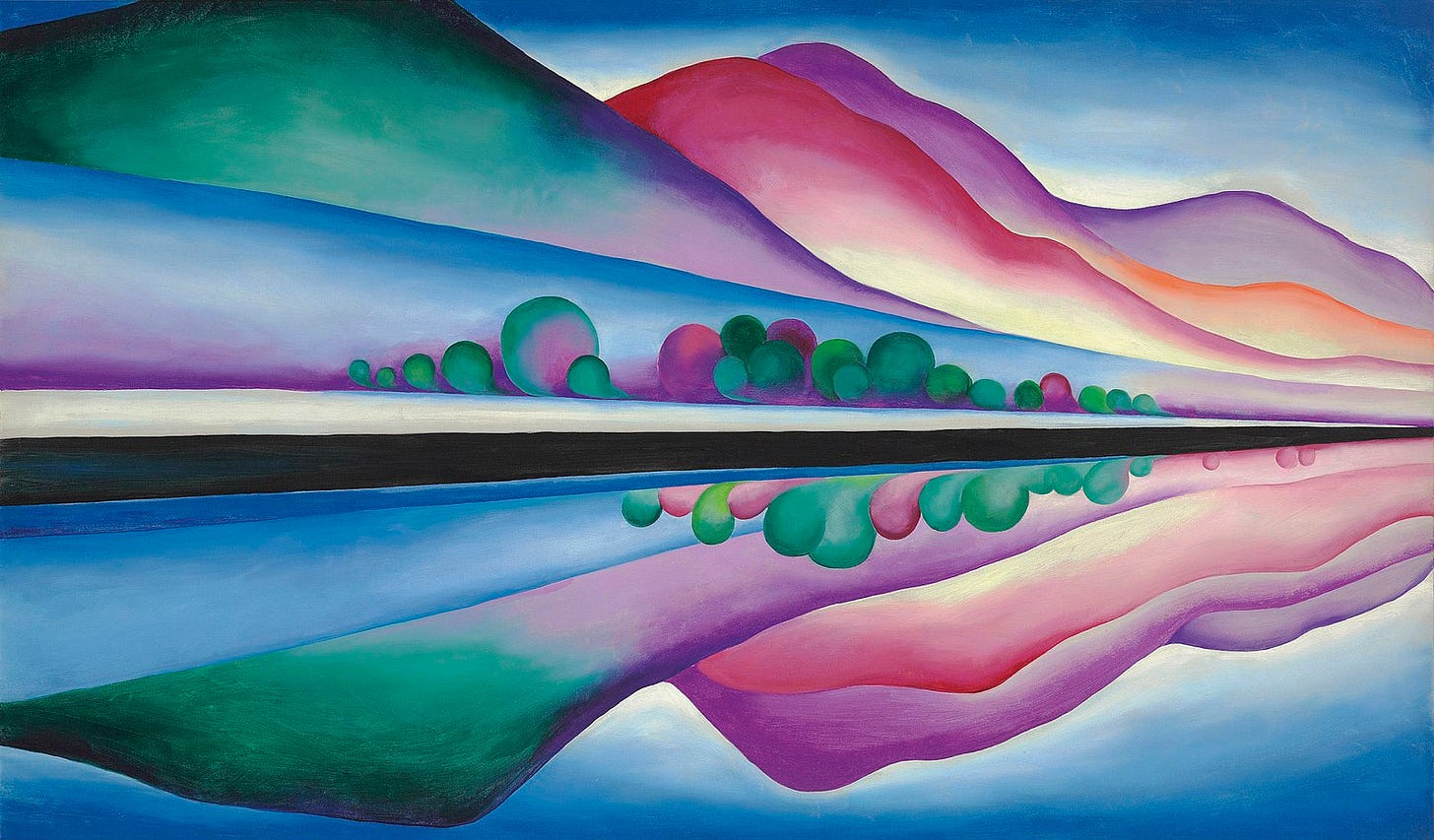

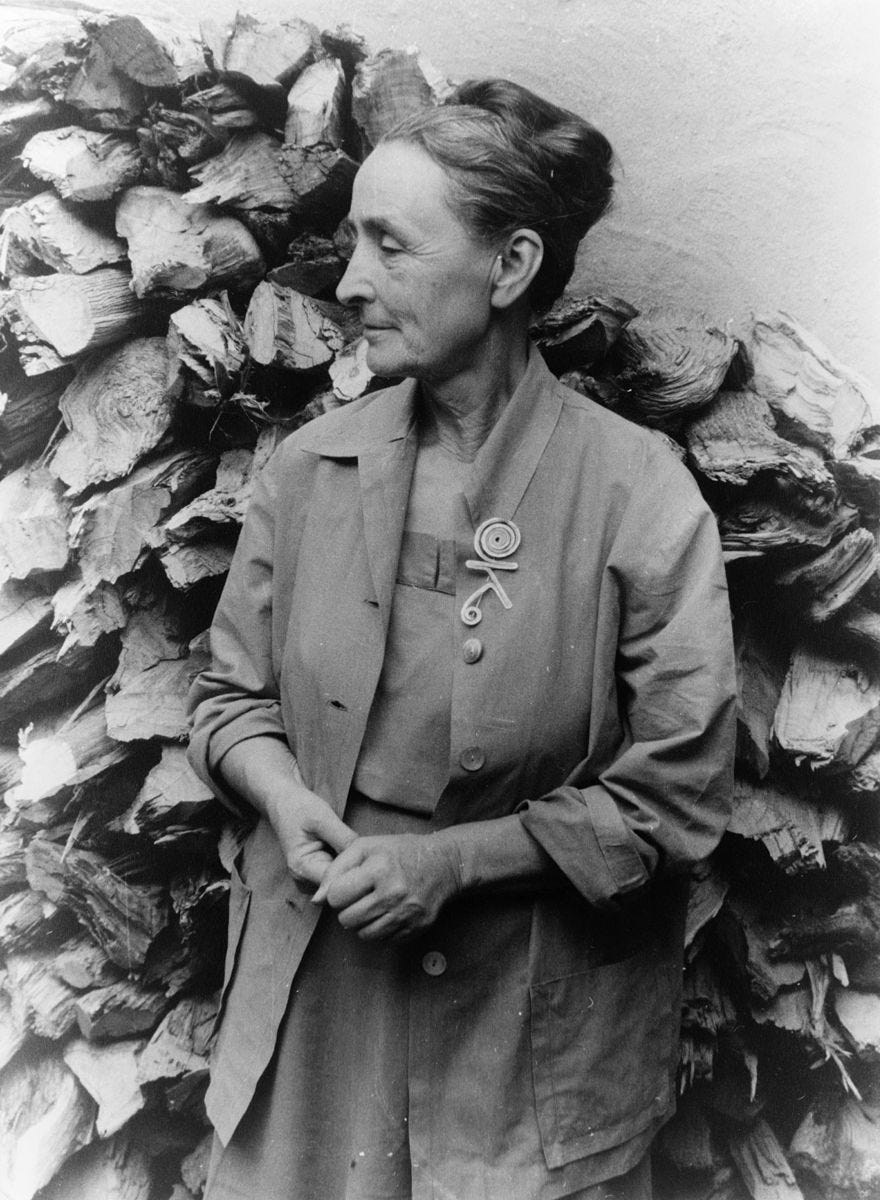
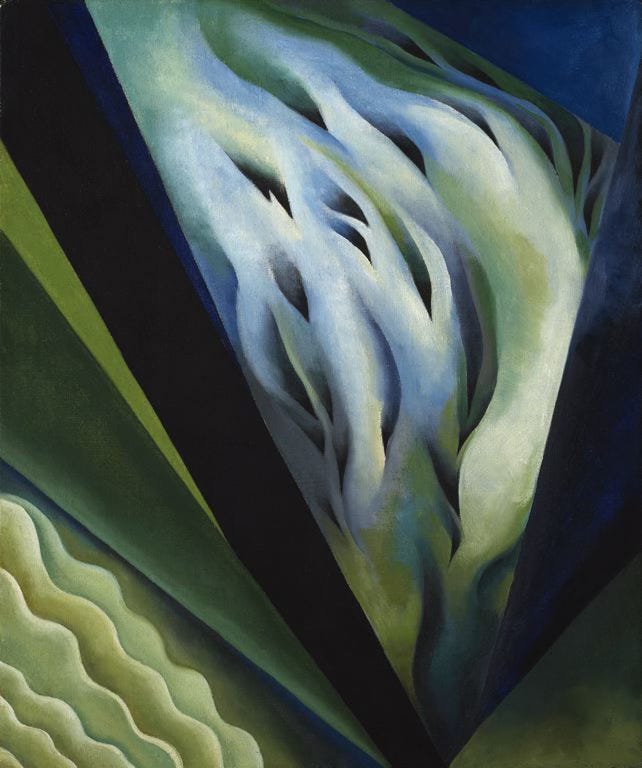

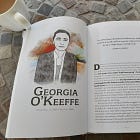
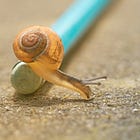
This series has been very interesting. I've always been a fan of O'Keefe but was ignorant about the details of her life or her struggles with mental health